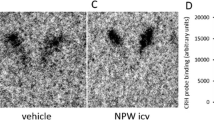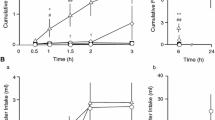Summary
Electrical activity of neurons in rat hypothalamic ventromedial nucleus was recorded in tissue slices, to investigate central neural mechanisms underlying reduction of food intake caused by TRH and its metabolite, cyclo(His-Pro) [cHP]. Application of TRH had two actions: stimulation of neuronal activity, which was desensitized on closely repeated applications; and modulation of neuronal responses to neurotransmitters, even in the absence of the stimulatory action. The neuromodulatory but not the direct stimulatory action could also be achieved by cHP. The neuromodulatory action is more likely to be a neural mechanism underlying the inhibition of feeding, while other biological functions, unique to TRH, may depend on direct stimulation. In this way, TRH could achieve different biological results through different modes of action on hypothalamic neurons.
Similar content being viewed by others
References
Beatty WW, O'Briant DA, Vilberg TR (1974) Suppression of feeding by intrahypothalamic implants of estradiol in male and female rats. Bull Psychon Soc 3: 273–274
Braitman DJ, Auker CR, Carpenter DO (1980) TRH has multiple actions in cortex. Brain Res 194: 244–248
Burt DR, Taylor RL (1980) Binding sites for thyrotropin-releasing hormone in sheep nucleus accumbens resemble pituitary receptors. Endocrinology 106: 1416–1423
Butera PD, Czaja JA (1984) Intracranial estradiol in ovariectomized guinea pigs: effects on ingestive behaviors and body weight. Brain Res 322: 41–48
Conn PM, Hsueh AJW, Crowley WF Jr (1984) Gonadotropinreleasing hormone: molecular and cell biology, physiology, and clinical applications. Fed Proc 43: 2351–2361
Donohoe TP, Stevens R (1982) Modulation of food intake by hypothalamic implants of estradiol benzoate, estrone, estriol, and CI-628 in female rats. Pharmacol Biochem Behav 16: 93–99
Dyer RG, Dyball REJ (1974) Evidence for a direct effect of LRF and TRF on single unit activity in the rostral hypothalamus. Nature 252: 486–488
Gershengorn MC, Thaw C (1985) Thyrotropin-releasing hormone (TRH) stimulates biphasic elevation of cytoplasmic free calcium in GH3 cells. Further evidence that TRH mobilizes cellular and extracellular Ca2+. Endocrinology 116: 591–596
Hawkins EF, Engel WK (1985) Analog specificity of the thyrotropin-releasing hormone receptor in the central nervous system: possible clinical implications. Life Sci 36: 601–611
Ishibashi S, Oomura Y, Okajima T (1979) Facilitatory and inhibitory effects of TRH on lateral hypothalamic and ventromedial neurons. Physiol Behav 22: 785–787
Kato Y, Kanno T (1983) Thyrotropin-releasing hormone injected intracerebroventricularly in the rat stimulates exocrine pancreatic secretion via the vagus nerve. Regul Peptides 7: 347–356
Kawakami M, Sakuma Y (1976) Electrophysiological evidences for possible participation of periventricular neurons in anterior pituitary regulation. Brain Res 101: 79–94
Kow L-M, Pfaff DW (1983) Neuronal responses to somatosensory and neuropharmacological stimuli in vivo and in vitro: effects of hormonal conditions. In: Bandler R (ed) Modulation of sensorimotor activity during alterations in behavioral states. Alan R. Liss Inc, New York, pp 217–230
Kow L-M, Pfaff DW (1984) Suprachiasmatic neurons in tissue slices from ovariectomized rats: electrophysiological and neuropharmacological characterization and the effects of estrogen treatment. Brain Res 297: 275–286
Kow L-M, Pfaff DW (1985a) Estrogen effects on neuronal responsiveness to electrical and neurotransmitter stimulation: an in vitro study on the ventromedial nucleus of the hypothalamus. Brain Res 347: 1–10
Kow L-M, Pfaff DW (1985b) Actions of feeding-relevant agents on hypothalamic glucose-responsive neurons in vitro. Brain Res Bull 15: 509–513
Kow L-M, Pfaff DW (1987) Responses of ventromedial hypothalamic neurons in vitro to norepinephrine: dependence on dose and receptor type. Brain Res (in press)
Morley JE, Levine AS (1980) Thyrotropin releasing hormone suppresses stress induced eating. Life Sci 27: 269–274
Morley JE, Levine AS, Prasad C (1981) Histidyl-proline diketopiperazine decreases food intake in rats. Brain Res 210: 475–478
Morley JE, Levine AS, Murray SS, Kneip J (1982) Peptidergic regulation of norepinephrine induced feeding. Pharmacol Biochem Behav 16: 225–228
Moss RL, Dudley CA (1978) Changes in responsiveness of medial preoptic neurons to the microelectrophoresis of releasing hormones as a function of ovarian hormones. Brain Res 149: 511–515
Moss RL, Kelly MJ, Dudley CA (1978) Chemosensitivity of hypophysiotropic neurons to the microelectrophoresis of biogenic amines. Brain Res 139: 141–152
Ogawa N, Yamawaki Y, Kuroda H, Ofuji T, Itoga E, Kito S (1980) Properties and distribution of thyrotropin-releasing hormone receptors in the central nervous system. In: Yoshida H, Yamamura HI (eds) Pharmacological and biochemical aspects of neurotransmitter receptors. John Wiley and Sons, New York, pp 191–203
Ono T, Nishino H, Fukuda M, Sasaki K, Muramoto K-I, Oomura Y (1982) Glucoresponsive neurons in rat ventromedial hypothalamic tissue slices in vitro. Brain Res 232: 494–499
Oomura Y (1980) Input-output organization in the hypothalamus relating to food intake behavior. In: Morgane PJ, Panksepp J (eds) Physiology of the hypothalamus Handbook of the hypothalamus, Vol 2. Marcel Dekker, Inc, New York, pp 557–620
Peterkofsky A, Battaini F, Koch Y, Takahara Y, Dannies P (1982) Histidyl-proline-diketopiperazine: its biological role as a regulatory peptide. Mol Cell Biochem 42: 45–63
Phillis JW, Kirkpatrick JR (1980) The actions of motilin, luteinizing hormone releasing hormone, cholecystokinin, somatostatin, vasoactive intestinal peptide, and other peptides on rat cerebral cortical neurons. Can J Physiol Pharmacol 58: 612–623
Pilotte NS, Sharif NA, Burt DR (1984) Characterization and autoradiographic localization of TRH receptors in sections of rat brain. Brain Res 293: 372–376
Prasad C, Mori M, Wilber JF, Pierson W, Pegues J, Jayaraman A (1982) Distribution and metabolism of cyclo(His-Pro): a new member of the neuropeptide family. Peptides 3: 591–598
Renaud LP, Martin JB (1975) Thyrotropin releasing hormone (TRH): depressant action on central neuronal activity. Brain Res 86: 150–154
Renaud LP, Martin JB, Brazeau P (1975) Depressant action of TRH, LHRH and somatostatin on activity of central neurones. Nature 255: 233–235
Renaud LP, Martin JB, Brazeau P (1976) Hypothalamic releasing factors: physiological evidence for a regulatory action on central neurons and pathways for their distribution in brain. Pharmacol Biochem Behav 5 (Suppl 1): 171–178
Renaud LP, Blume HW, Pittman Q, Lamour Y, Tan AT (1979) Thyrotropin-releasing hormone selectively depresses glutamate excitation of cerebral cortical neurons. Science 205: 1275–1277
Rostene WH, Morgat J-L, Dussaillant M, Rainbow TC, Sarrieau A, Vial M, Rosselin G (1984) In vitro biochemical characterization and autoradiographic distribution of 3H-thyrotropinreleasing hormone binding sites in rat brain sections. Neuroendocrinology 39: 81–86
Sharif NA, Burt DR (1983) Rat brain TRH receptors: kinetics, pharmacology, distribution and ionic effects. Regul Peptides 7: 399
Stone TW (1983) Actions of TRH and cyclo-(His-Pro) on spontaneous and evoked activity of cortical neurones. Eur J Pharmacol 92: 113–118
Tsay BL, Lin MT (1982) Effects of intracerebroventricular administration of thyrotrophic-releasing hormone on cardiovascular function in the rat. Neuroendocrinology 35: 173–177
Wade GN, Zucker I (1970) Modulation of food intake and locomotor activity in female rats by diencephalic hormone implants. J Comp Physol Psychol 72: 328–336
Winokur A, Beckman AL (1978) Effects of thyrotropin releasing hormone, norepinephrine and acetylcholine on the activity of neurons in the hypothalamus, septum and cerebral cortex of the rat. Brain Res 150: 205–209
Yarbrough GG (1976) TRH potentiates excitatory action of acetylcholine or cerebral cortical neurones. Nature 263: 523–524
Author information
Authors and Affiliations
Rights and permissions
About this article
Cite this article
Kow, L.M., Pfaff, D.W. Neuropeptides TRH and cyclo(His-Pro) share neuromodulatory, but not stimulatory, action on hypothalamic neurons in vitro: implication for the regulation of feeding. Exp Brain Res 67, 93–99 (1987). https://doi.org/10.1007/BF00269457
Received:
Accepted:
Issue Date:
DOI: https://doi.org/10.1007/BF00269457




